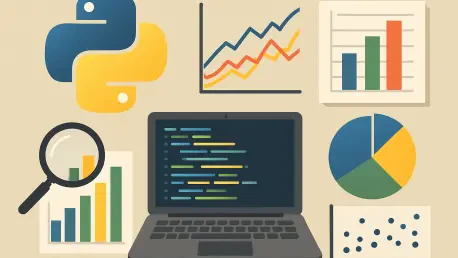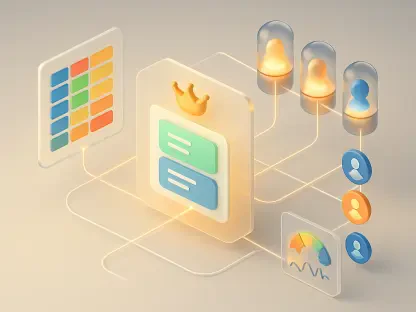Picture a data scientist buried under terabytes of raw information, racing against a deadline to deliver insights that could reshape a company’s strategy, while the clock ticks relentlessly. Traditional Python libraries strain under the load, slowing down every step from data loading to analysis. This scenario is all too common in today’s data-driven landscape, where the sheer volume and complexity of information can overwhelm even seasoned professionals. Yet, amid this chaos, a new breed of tools for Python is emerging, promising to transform bottlenecks into breakthroughs. These innovations are not just upgrades—they’re game-changers for anyone navigating the data science maze.
Why These Tools Are a Big Deal Now
The stakes in data science have never been higher. With businesses relying on real-time insights to outpace competitors, the demand for faster, more efficient workflows is relentless. Classic Python libraries like Pandas and Scikit-learn, while foundational, often falter when faced with massive datasets or intricate pipelines. This gap has sparked the rise of specialized tools designed to tackle specific pain points, from sluggish processing to inconsistent results. Their importance lies in empowering data scientists to handle larger volumes, ensure reproducibility, and deliver results at unprecedented speeds, making them indispensable in a world where data is the ultimate currency.
Diving Deep into the 7 Trailblazers
ConnectorX: Turbocharging Data Transfers
One standout in the lineup is ConnectorX, a tool built to slash the time spent loading data from databases into Python. Powered by Rust, it leverages parallel processing to support systems like PostgreSQL and MySQL, cutting transfer times significantly. For projects dealing with sprawling datasets, this means hours saved, allowing focus on analysis rather than waiting for data to load.
DuckDB: Lightweight Powerhouse for Analytics
Next up, DuckDB offers a refreshing take on analytical queries with its in-process database design. Using columnar storage, it delivers blazing-fast performance for tasks involving diverse formats like CSV and JSON. Ideal for those needing quick insights without the hassle of server setups, DuckDB streamlines workflows where agility is key, proving that lightweight doesn’t mean less capable.
Polars: Outrunning Pandas with Ease
Polars emerges as a high-octane alternative to Pandas, also harnessing Rust for superior performance. Its automatic optimizations and parallel processing capabilities make it a go-to for handling big data, often outpacing traditional tools by wide margins. While its streaming features are still evolving, Polars is already a favorite for data scientists craving speed without sacrificing functionality.
Optimus: Simplifying the Mess of Data Prep
Data cleaning, often a tedious chore, gets a boost with Optimus and its user-friendly API. Supporting multiple engines like Dask and Spark, it tackles preprocessing with ease, saving valuable time. Though its last update raises some questions about ongoing development, its current capabilities still make it a handy ally for wrangling messy datasets into shape.
Cleanlab: Polishing Datasets for Precision
Cleanlab steps in to address a critical yet overlooked aspect—dataset quality. Specializing in identifying and correcting labeling errors for machine learning, it works across frameworks, enhancing tasks like image segmentation. By ensuring cleaner inputs, Cleanlab helps models achieve better accuracy, addressing a foundational need before any algorithm runs.
DVC: Mastering Data Version Control
Collaboration and reproducibility find a champion in DVC, or Data Version Control. Syncing datasets with Git, it extends version control beyond code, offering features like data caching and experiment tracking. For teams juggling complex projects, DVC ensures that data integrity remains intact, solving a persistent challenge in maintaining consistency across iterations.
Snakemake: Orchestrating Seamless Pipelines
Rounding out the list, Snakemake automates data analysis pipelines with a structure reminiscent of GNU Make. Its multithreading and cloud portability features cater to intricate projects, ensuring consistent outputs across teams. While it demands a learning curve, the payoff in streamlined, repeatable workflows makes it a powerful asset for scaling operations.
Real Stories, Real Impact
The excitement surrounding these tools isn’t just theoretical—it’s echoed by those in the trenches. A data engineer shared on a community platform, “Polars turned my big data grind into a breeze; it’s like night and day compared to Pandas.” Industry reports back this up, noting that DuckDB can execute analytical queries up to 50 times faster than conventional setups in specific cases. Another practitioner raved about Cleanlab, stating, “It flagged errors in my labels that could’ve derailed my model—weeks of rework avoided.” These testimonials, alongside growing adoption in open-source circles, paint a vivid picture of transformation, proving that these tools are already reshaping how data science unfolds.
Making These Tools Work for You
Adopting these innovations doesn’t require a complete overhaul of existing systems. Start by pinpointing the most pressing challenges—opt for ConnectorX or Polars if data loading or processing lags are the issue. For rapid analytical tasks, integrating DuckDB can eliminate setup delays with its in-process design. When data quality hinders progress, tools like Optimus for cleaning or Cleanlab for label refinement can make a marked difference. For collaborative efforts, DVC ensures datasets stay tracked alongside code, while Snakemake automates multi-step pipelines, especially useful in cloud environments. Begin with a single tool on a small project, leveraging robust documentation and community support to ease the transition. Matching the right solution to specific needs can elevate productivity without disrupting established workflows.
Reflecting on a Data-Driven Shift
Looking back, the journey through these seven tools revealed a landscape of innovation that tackled data science’s toughest hurdles head-on. Their impact was felt in faster processing, cleaner datasets, and automated pipelines that saved countless hours. As the field continues to evolve, the next steps were clear: experiment with these tools to uncover their full potential, tailor them to unique challenges, and stay attuned to updates that could further refine their capabilities. The path forward promised even greater efficiency, with a commitment to harnessing such advancements ensuring that no dataset remained too daunting to conquer.









